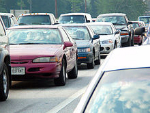 Nearly all major newspapers around the country on March 10th proclaimed this news: the use of public transit last year reached its highest level since 1956. The somewhat breathless New York Times story read like a news release from the American Public Transportation Association (APTA), including the claim from APTA president Michael Melaniphy that “We’re seeing a fundamental shift in how people are moving about their communities.” As far as I could tell, the only transportation reporter who did some independent homework on this story was USA Today’s Larry Copeland, who got some very useful context from commuting expert Alan Pisarski.
Nearly all major newspapers around the country on March 10th proclaimed this news: the use of public transit last year reached its highest level since 1956. The somewhat breathless New York Times story read like a news release from the American Public Transportation Association (APTA), including the claim from APTA president Michael Melaniphy that “We’re seeing a fundamental shift in how people are moving about their communities.” As far as I could tell, the only transportation reporter who did some independent homework on this story was USA Today’s Larry Copeland, who got some very useful context from commuting expert Alan Pisarski.
So what’s the real story here? First, as academics David King, Michael Manville, and Michael Smart pointed out in an op-ed in the Washington Post 10 days later, although total transit trips have risen since their nadir in 1972, so has population. Even just between 2008 and 2012 they pointed out, average transit trips per capita have declined from 35 to 34. And transit consultant Thomas Rubin noted that since 1956, the population has increased by 85%. So if 2013’s 10.65 billion trips now equal those of 1956, the annual average trips per capita has shrunk by nearly half, from 62.5 to 34.
But it gets worse. Cato’s Randal O’Toole looked into the 2013 transit trip numbers and found that the increase in transit trips in New York City was 123 million. But the total national increase, as reported by APTA, was just 115 million. In other words, apart from New York City, there was no increase at all, on average, across the country. APTA quickly responded that some other individual cities did have increases, but in fact most experienced decreases.
And there’s more, undercutting the idea that a “fundamental shift in how people are moving about” is taking place. In a March 20th piece at NewGeography.com, demographer Wendell Cox analyzed commuting data from the Census Bureau’s American Community Survey. Here are the actual increases and decreases in daily one-way commuting trips from 2007 to 2012:
- Drive alone: +1,506,000
- Work at home (including telecommuting): +467,000
- Transit: +253,000
- Carpool: -812,000
- Other: +189,000
In 42 of the 52 major urban areas, the increase in working at home exceeded the increase (if any) in transit use.
In short, there is no meaningful shift to transit evident in the data. What we have here is a case of what statisticians call “torturing the data until it confesses” to the desired answer.
(This article first ran in Surface Transportation Innovations)
 Email this author
Email this author
- The Most Progressive Budget in Virginia’s History - December 21, 2019
- When is a Clean Water Act Permit Needed? - December 21, 2019
- Should U.S. Consider Modern Monetary Theory to Improve Economy? - December 21, 2019
